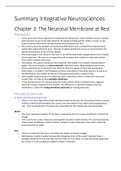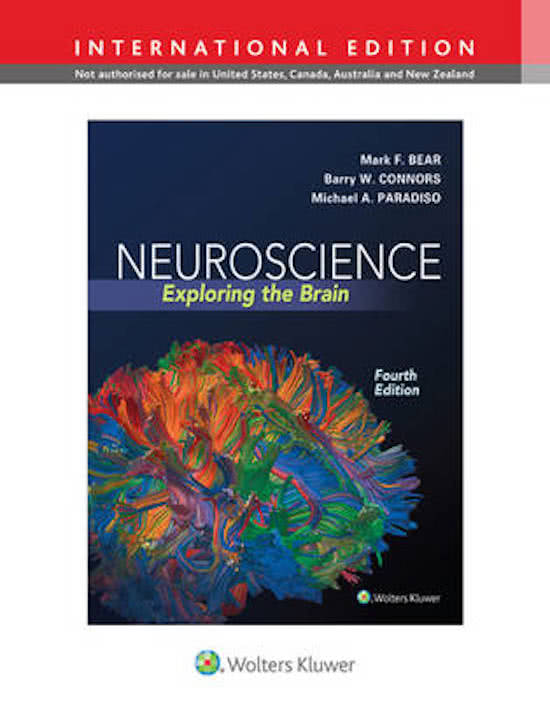Summary Integrative Neurosciences
Chapter 3: The Neuronal Membrane at Rest
Introduction
o In the spinal cord, these signals are transferred to interneurons. Some of these neurons connect
with the parts of your brain that interpret the signals as being painful. Others connect to the
motor neurons that control the leg muscles that withdraw your foot.
o The neuron solves the problem of conducting information over a distance by using electrical
signals that sweep along the axon. The type of signal used by the neuron is constrained by the
special environment of the nervous system.
o Electrical charge in the cytosol of the axon is carried by electrically charged atoms (ions) instead
of free electrons. The axon is not especially well insulated and is bathed in salty extracellular
fluid, which conducts electricity.
o Fortunately, the axonal membrane has properties that enable it to conduct a special type of
signal - the nerve impulse, or action potential - that overcomes these biological constraints.
o Action potentials do not diminish over distance; they are signals of fixed size and duration.
Information is encoded in the frequency of action potentials of individual neurons as well as in
the distribution and number of neurons firing action potentials in a given nerve.
o Cells capable of generating and conducting action potentials, which include both nerve and
muscle cells, are said to have excitable membrane.
o In the resting neuron, the cytosol along the inside surface of the membrane has a negative
electrical charge compared to the outside. This difference in electrical charge across the
membrane is called the resting membrane potential (or resting potential).
The Cast of Chemicals
C YTOSOL AND EXTRACELLULAR FLUID
o Water is the main ingredient of both the fluid inside the neuron, the intracellular fluid or cytosol,
and the outside fluid that bathes the neuron, the extracellular fluid. Electrically charged atoms –
ions - that are dissolved in this water are responsible for the resting and action potentials.
Water
o The most important property of the water molecule (H2O) is its uneven distribution of electrical
charge.
o H2O is said to be a polar molecule, held together by polar covalent bonds. This electrical polarity
makes water an effective solvent of other charged or polar molecules; other polar molecules
tend to dissolve in water.
Ions
o Atoms or molecules that have a net electrical charge are known as ions.
o Salt dissolves readily in water because the charged portions of the water molecule have a
stronger attraction for the ions than the ions have for each other. As each ion breaks away from
the crystal, it is surrounded by a sphere of water molecules.
, o The electrical charge of an atom depends on the difference between its numbers of protons and
electrons. Ions with a net positive charge are called cations; ions with a negative charge are
called anions.
Channel Proteins
o Regions where nonpolar R groups are exposed are hydrophobic and tend to associate readily
with lipid. Regions with exposed polar R groups are hydrophilic and tend to avoid a lipid
environment.
o A protein that is suspended in a phospholipid bilayer, has its hydrophobic portion inside the
membrane and its hydrophilic ends exposed to the watery environments on either side.
o Ion channels are made from just these sorts of membrane-spanning protein molecules. Typically,
a functional channel across the membrane requires that four to six similar protein molecules
assemble to form a pore between them.
o One important property of most ion channels, specified by the diameter of the pore and the
nature of the R groups lining it, is ion selectivity. Another important property of many channels
is gating. Channels with this property can be opened and closed – gated - by changes in the local
microenvironment of the membrane.
Ion Pumps
o In addition to those that form channels, other membrane-spanning proteins come together to
form ion pumps. Ion pumps are enzymes that use the energy released by the breakdown of ATP
to transport certain ions across the membrane.
The Movement of Ions
o The existence of an open channel in the membrane does not necessarily mean that there is a net
movement of ions across the membrane. Such movement also requires that external forces be
applied to drive them across. Ionic movements through channels are influenced by two factors:
diffusion and electricity.
D IFFUSION
o Ions and molecules dissolved in water are in constant motion. Therefore, there is a net
movement of ions from regions of high concentration to regions of low concentration; this
movement is called diffusion.
o Although ions typically do not pass through a phospholipid bilayer directly, diffusion causes ions
to be pushed through channels in the membrane.
o Thus, we say that ions will flow down a concentration gradient (difference in concentration). The
movement of ions across the membrane by diffusion, therefore, happens when (1) the
membrane has channels permeable to the ions and (2) there is a concentration gradient across
the membrane.
ELECTRICITY
o Opposite charges attract and like charges repel. Consequently, there will be a net movement of
Na+ toward the negative terminal (the cathode) and of Cl- toward the positive terminal (the
anode). The movement of electrical charge is called electrical current.
o Two important factors determine how much current will flow: electrical potential and electrical
conductance. Electrical potential, also called voltage, is the force exerted on a charged particle;
it reflects the difference in charge between the anode and the cathode.
, o Electrical conductance is the relative ability of an electrical charge to migrate from one point to
another. Conductance depends on the number of ions or electrons available to carry electrical
charge, and the ease with which these charged particles can travel through space.
o A term that expresses the same property in a different way is electrical resistance, the relative
inability of an electrical charge to migrate.
o There is a simple relationship between potential (V), conductance (g), and the amount of current
(I) that will flow. This relationship, known as Ohm’s law. Current is the product of the
conductance and the potential difference.
The Ionic Basis of the Resting Membrane Potential
o The membrane potential is the voltage across the neuronal membrane at any moment. Vm can
be measured by inserting a microelectrode into the cytosol. A typical microelectrode is a thin
glass tube with an extremely fine tip (diameter 0.5 µm) that can penetrate the membrane of a
neuron with minimal damage.
o It is filled with an electrically conductive salt solution and is connected to a device called a
voltmeter. The voltmeter measures the electrical potential difference between the tip of this
microelectrode and a wire placed outside the cell.
o The resting potential of a typical neuron is about -65 millivolts. Stated another way, for a neuron
at rest, Vm = 65 mV. This negative resting membrane potential of the neuron is an absolute
requirement for a functioning nervous system.
EQUILIBRIUM POTENTIALS
o The electrical potential difference that exactly balances an ionic concentration gradient is called
an ionic equilibrium potential, or simply equilibrium potential, and it is represented by the
symbol Eion.
o Large changes in membrane potential are caused by minuscule changes in ionic concentrations.
o The net difference in electrical charge occurs at the inside and outside surfaces of the
membrane.
o Ions are driven across the membrane at a rate proportional to the difference between the
membrane potential and the equilibrium potential.
o If the concentration difference across the membrane is known for an ion, the equilibrium
potential can be calculated for that ion.
Chapter 4: The Action Potential
o The action potentials generated by a patch of membrane are all similar in size and duration, and
they do not diminish as they are conducted down the axon.
o The frequency and pattern of action potentials constitute the code used by neurons to transfer
information from one location to another.
Properties of the Action Potential
THE UPS AND DOWNS OF AN ACTION POTENTIAL
o The first part, called the rising phase, is characterized by a rapid depolarization of the
membrane. This change in membrane potential continues until Vm reaches a peak value of about
40 mV.
, o The part of the action potential where the inside of the neuron is positively charged with respect
to the outside is called the overshoot.
o The falling phase of the action potential is a rapid repolarization until the inside of the
membrane is actually more negative than the resting potential.
o This last part of the falling phase is called the undershoot, or
after-hyperpolarization. Finally, there is a gradual restoration of
the resting potential. From beginning to end, the action potential
lasts about 2 milliseconds (msec).
THE GENERATION OF AN ACTION POTENTIAL
o The membrane of nerve fibers have a type of gated sodium
channel that opens when the nerve ending is stretched. The
chain of events therefore begins this way: (1) The thumbtack
enters the skin, (2) the membrane of the nerve fibers in the skin
is stretched, (3) and Na+-permeable channels open.
o Because of the large concentration gradient and the negative charge of the inside of the
membrane, Na+ crosses the membrane through these channels. The entry of Na+ depolarizes the
membrane.
o If this depolarization achieves a critical level, the membrane will generate an action potential.
The critical level of depolarization that must be reached in order to trigger an action potential is
called threshold.
THE GENERATION OF MULTIPLE ACTION POTENTIALS
o The rate of action potential generation depends on the magnitude of the continuous
depolarizing current.
o Thus, the firing frequency of action potentials reflects the magnitude of the depolarizing current.
This is one way that stimulation intensity is encoded in the nervous system.
o Although firing frequency increases with the amount of depolarizing current, there is a limit to
the rate at which a neuron can generate action potentials.
o The maximum firing frequency is about 1000
Hz; once an action potential is initiated, it is
impossible to initiate another for about 1 msec.
This period of time is called the absolute
refractory period.
o It can be relatively difficult to initiate another
action potential for several milliseconds after
the end of the absolute refractory period.
During this relative refractory period, the
amount of current required to depolarize the
neuron to action potential threshold is elevated
above normal.
The Action Potential, in Reality
o When the membrane is depolarized to threshold, there is a transient increase in g Na. The
increase in gNa allows the entry of Na+, which depolarizes the neuron.
o Restoring the negative membrane potential would be further aided by a transient increase in g K
during the falling phase, allowing K+ to leave the depolarized neuron faster.






